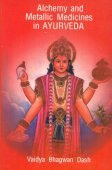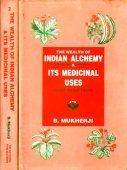Shalyatantra, Śalyatantra, Shalya-tantra, Shalyatamtra: 6 definitions
Introduction:
Shalyatantra means something in Hinduism, Sanskrit. If you want to know the exact meaning, history, etymology or English translation of this term then check out the descriptions on this page. Add your comment or reference to a book if you want to contribute to this summary article.
The Sanskrit term Śalyatantra can be transliterated into English as Salyatantra or Shalyatantra, using the IAST transliteration scheme (?).
In Hinduism
Ayurveda (science of life)
Source: archive.org: Sushruta samhita, Volume IThe Shalya-Tantras (surgical works) written or propagated by Aupadhenava, Aurabhra, Sushruta and Paushkalávata, are the bases of the works or Tantras written by others (Karavirya, Gopura-rakshita, etc.).

Āyurveda (आयुर्वेद, ayurveda) is a branch of Indian science dealing with medicine, herbalism, taxology, anatomy, surgery, alchemy and related topics. Traditional practice of Āyurveda in ancient India dates back to at least the first millenium BC. Literature is commonly written in Sanskrit using various poetic metres.
Shaivism (Shaiva philosophy)
Source: Shodhganga: Mantra-sādhana: Chapter One of the KakṣapuṭatantraŚalyatantra (शल्यतन्त्र) is the name of an Āgama or Tantra mentioned in the Kakṣapuṭatantra verse 1.5-7.—“At a previous time, when Pārvatī asked him, Śaṅkara told of the attainments of vidyā in the wide worldly life, in various ways. I observed each teaching taught also by the troops of Gods, Siddhas (those who have attained supernatural power), Munis (saints), Deśikas (spiritual teachers), and Sādhakas (tantric practicioners). They are [, for example]: Śalyatantra... I shall carefully extract all the above-mentioned āgamas, which are transmitted from mouth to mouth, like butter extracted from coagulated milk”.

Shaiva (शैव, śaiva) or Shaivism (śaivism) represents a tradition of Hinduism worshiping Shiva as the supreme being. Closely related to Shaktism, Shaiva literature includes a range of scriptures, including Tantras, while the root of this tradition may be traced back to the ancient Vedas.
General definition (in Hinduism)
Source: WikiPedia: HinduismAs war was a major cause of injury, the name Salya-tantra for this branch of medical learning is derived from Salya, the arrow of the enemy, which in fights used to be lodged in the body of the soldiers. He emphasises that removal of foreign bodies is fraught with certain complications if the seat of the Salya be a marma.
Languages of India and abroad
Sanskrit dictionary
Source: Cologne Digital Sanskrit Dictionaries: Aufrecht Catalogus Catalogorum1) Śalyatantra (शल्यतन्त्र) as mentioned in Aufrecht’s Catalogus Catalogorum:—cure of dangerous diseases by magical means. L. 2255. K. 52.
2) Śalyatantra (शल्यतन्त्र):—tantric medicaments for the cure of dangerous diseases. Peters. 4, 43.
Source: Cologne Digital Sanskrit Dictionaries: Monier-Williams Sanskrit-English DictionaryŚalyatantra (शल्यतन्त्र):—[=śalya-tantra] [from śalya > śal] n. Name of [chapter] of medical [work]
Sanskrit, also spelled संस्कृतम् (saṃskṛtam), is an ancient language of India commonly seen as the grandmother of the Indo-European language family (even English!). Closely allied with Prakrit and Pali, Sanskrit is more exhaustive in both grammar and terms and has the most extensive collection of literature in the world, greatly surpassing its sister-languages Greek and Latin.
Kannada-English dictionary
Source: Alar: Kannada-English corpusŚalyataṃtra (ಶಲ್ಯತಂತ್ರ):—[noun] the branch of ayurvedic medicine dealing with the treatment of disease, injury or deformity by instrumental operations; ayurvedic surgery.
Kannada is a Dravidian language (as opposed to the Indo-European language family) mainly spoken in the southwestern region of India.
See also (Relevant definitions)
Partial matches: Shalya, Tantra.
Full-text: Ashtanga, Paushkalavata, Shodashanga, Ayurveda.
Relevant text
Search found 8 books and stories containing Shalyatantra, Śalya-tantra, Salya-tantra, Śalyataṃtra, Salyatamtra, Śalyatantra, Salyatantra, Shalya-tantra, Shalyatamtra; (plurals include: Shalyatantras, tantras, Śalyataṃtras, Salyatamtras, Śalyatantras, Salyatantras, Shalyatamtras). You can also click to the full overview containing English textual excerpts. Below are direct links for the most relevant articles:
History of Indian Medicine (and Ayurveda) (by Shree Gulabkunverba Ayurvedic Society)
Chapter 4 - Text Books of Medicine < [Part 2-3 - Medical Institutions in Ancient India]
Chapter 4 - The Story of Atreya < [Part 1 - The History of Medicine in India]
Atharvaveda and Charaka Samhita (by Laxmi Maji)
Dhanvantari (Āyurveda scholar) < [Chapter 1 - Introduction]
History of Āyurveda < [Chapter 1 - Introduction]
Sushruta Samhita, volume 1: Sutrasthana (by Kaviraj Kunja Lal Bhishagratna)
Charaka Samhita and Sushruta Samhita (by Nayana Sharma)
The perception of surgery < [Chapter 9]
The Saṃhitās (Introduction) < [Chapter 1]
Sushruta Samhita, volume 3: Sharirasthana (by Kaviraj Kunja Lal Bhishagratna)
Chapter V - The anatomy of the human body
Chapter IX - The description of the arteries, nerves and ducts
The Concept of Sharira as Prameya (by Elizabeth T. Jones)
Śarīra in Āyurveda < [Chapter 5]
Related products

